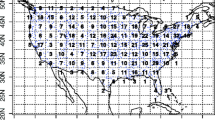Summary.
Climatic fluctuations in KwaZulu-Natal, southeastern South Africa, are analysed using statistical techniques. Moist easterly winds sweep in from the Indian Ocean during all seasons except winter, producing a balance between evaporative losses and precipitation. The seasonal cycle is unimodal with a peak of rainfall and temperature in the summer months (December to February) with a 1–2 month lag for streamflow and vegetation growth. Rainfall and temperature departures in recent decades exhibit a 3 year cycle and a 3–6 month persistence of cool/wet or warm/dry phases. The predictability of summer rainfall, temperature, crop yield, inflow to dams and malaria incidence is explored. Multivariate linear regression models with lead-times of one season account for two-thirds of the variance in most cases. Climatic signals which enable predictability include winds over the tropical east Atlantic and north Indian Ocean. El Niño signals from tropical Pacific sea surface temperatures and the Southern Oscillation Index are also important predictors for KwaZulu-Natal’s climate. These relationships suggest that local circulation responses to large scale tropical-polar temperature gradients govern climatic fluctuations over KwaZulu-Natal.
Similar content being viewed by others
Author information
Authors and Affiliations
Additional information
Received August 27, 1997. Revised November 10, 1997
Rights and permissions
About this article
Cite this article
Jury, M. Statistical Analysis and Prediction of KwaZulu-Natal Climate. Theor Appl Climatol 60, 1–10 (1998). https://doi.org/10.1007/s007040050029
Issue Date:
DOI: https://doi.org/10.1007/s007040050029




